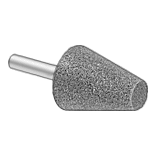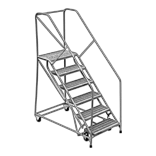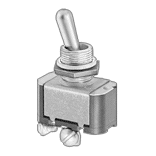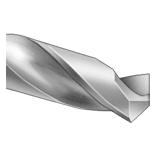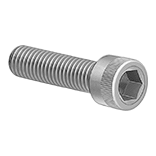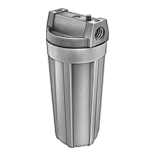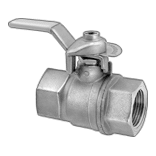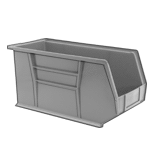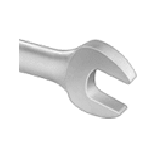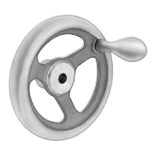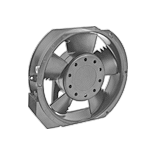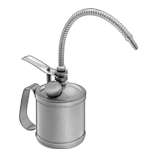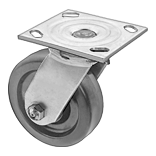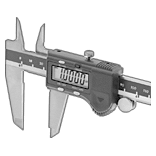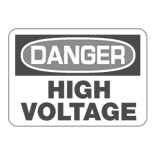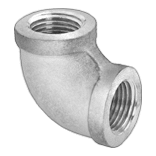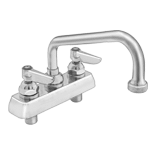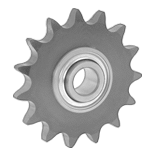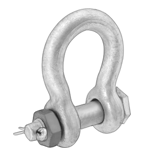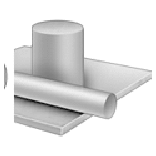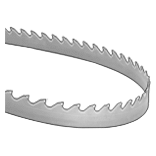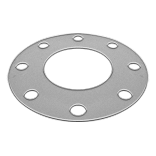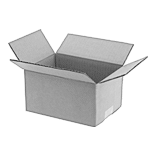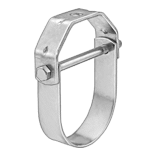About Carbon Steel, Alloy Steel, Spring Steel, and Cast Iron
More
About Plastic
More
Impact-Resistant 440A Stainless Steel
440A stainless steel resists damage from impact and abrasion.
Sheets are often used for cutlery and valve components. They maintain their corrosion resistance in temperatures up to 1920° F.
For technical drawings and 3-D models, click on a part number.
![]() Certificates with a traceable lot number are available for these products. Download certificates from ORDER HISTORY after your order ships.
Certificates with a traceable lot number are available for these products. Download certificates from ORDER HISTORY after your order ships.
High-Temperature Aluminized Low-Carbon Steel Sheets

- Yield Strength: See table
- Hardness: Not Rated
- Heat Treatable: No
- Fabrication: Cold Worked
- Specifications Met: ASTM A463
Coated with an aluminum-silicon alloy, these sheets resist corrosion while withstanding long-term exposure to high temperatures. Low-carbon steel, also known as mild steel, is easy to machine, form, and weld. Use these sheets in drying ovens, furnaces, and smokestacks. They have been manufactured to meet ASTM A463 standards for quality and performance.
For technical drawings and 3-D models, click on a part number.
![]() Certificates with a traceable lot number are available for these products. Download certificates from ORDER HISTORY after your order ships.
Certificates with a traceable lot number are available for these products. Download certificates from ORDER HISTORY after your order ships.
Slippery UHMW Polyethylene Film

- Color: Off-White
- Temperature Range: See Table
- Tensile Strength: 5,500-6,000 psi (Good)
- Impact Strength: Not Rated
- Hardness: Durometer 65D (Medium)
- For Use Outdoors: See Table
- Specifications Met: See Table
Widely used as a protective barrier against abrasion and wear, this UHMW film has a slippery surface that prevents sticking. This film is skived, so the edges may curl.
For adhesive-back film that is FDA compliant, the film meets the standard, but the adhesive does not.
For technical drawings and 3-D models, click on a part number.
12" × 12" | |||||||
|---|---|---|---|---|---|---|---|
| Thick. | Thick. Tolerance | For Use Outdoors | Max. Temp., °F | Specifications Met | Adhesive Type | Each | |
Semi-Clear Adhesive-Back Film | |||||||
| 0.047" | -0.0043" to 0.001" | Yes | 200° | ASTM D4020, FDA Compliant 21 CFR 177.1520 | Acrylic | 0000000 | 000000 |
Impact- and Scratch-Resistant Corning® Gorilla® Glass

- Color: Clear
- Maximum Temperature: 1,000° F
Made of aluminosilicate that’s been chemically strengthened, this glass handles more wear and tear than other glass before scratching, cracking, or chipping. It’s often seen on mobile devices and enclosure display windows. This glass withstands drops without shattering from as high as two meters—twice that of standard aluminosilicate, often found as thermometer tubes. It’s also at least three times more resistant to scratching than standard aluminosilicate glass and significantly more so than most common glass. Compared to borosilicate and quartz, it’s harder and stiffer. It’s also more chemical resistant than borosilicate.
Because of how this glass is strengthened, it cannot be cut or trimmed without cracking or shattering. But, unlike glass that is strengthened through coatings, this glass remains optically clear and won’t distort objects. It also reduces glare.
For technical drawings and 3-D models, click on a part number.
Antimicrobial and Scratch-Resistant Corning® Gorilla® Glass


- Color: Clear
- Maximum Temperature: 1,065° F
Often seen on mobile devices, human-machine interfaces, and other frequently touched surfaces, this aluminosilicate glass has been chemically strengthened and treated to resist bacteria, mold, mildew, algae, and fungi. Gorilla® Glass 3 is harder and stiffer than borosilicate. It’s at least three times more resistant to scratching than standard aluminosilicate glass, often found as thermometer tubes, and significantly more so than most common glass. And it requires 150 times more weight to crack this glass than soda-lime glass, which is what most jars are made of. But because of how this glass is strengthened, it cannot be cut or trimmed without cracking or shattering.
While this glass doesn’t prevent the spread of viruses, its antimicrobial treatment does prevent the growth of 99.9% of bacteria. This treatment doesn’t change its clarity, unlike most coatings used to prevent bacteria on glass, so it remains optically clear and won’t distort objects.
Product registration requirements restrict sales to the listed areas.
For technical drawings and 3-D models, click on a part number.
